From coffee to beer: "boutique" can't do without good fermentation.
For professional baristas, please follow the coffee workshop (Wechat official account cafe_style)
The word "fermentation" in life is often reminiscent of flour making cakes, Youtiao, steamed buns, steamed buns, or moldy food products.
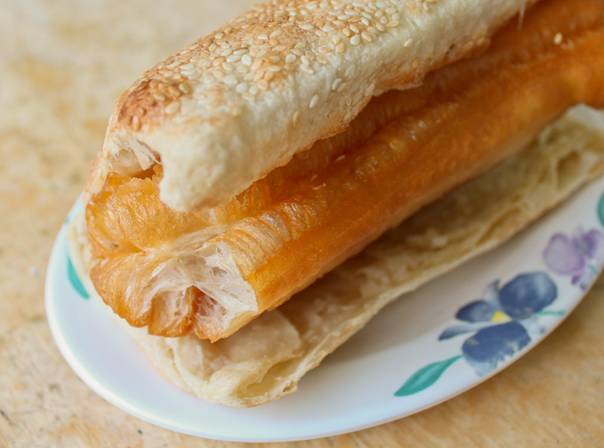
Pancake Youtiao also goes through a process of fermentation.
But in English, Fermentation is derived from the Latin fervere, which originally means "tumbling". It describes the phenomenon that yeast foams slightly or violently resembles boiling when yeast acts on grape juice or wort.
Whether making noodles or making wine, it depends on the life activities of microorganisms under aerobic or anaerobic conditions to prepare microbial bacteria themselves, or their direct metabolites or secondary metabolites.
The fermentation of beer
There is no doubt that beer is produced by fermentation, and the best-known formula for the fermentation of alcohol is that sugars produce alcohol and carbon dioxide by yeast. But in fact, the fermentation of beer is much more than alcohol. All kinds of flavors that people like and dislike need to be precisely controlled by the fermentation environment and state in order to produce more good flavors and less bad flavors.
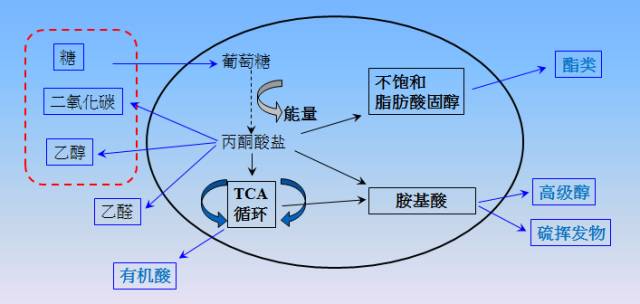
A simple schematic diagram of yeast metabolic cycle
Interestingly, in the process of beer fermentation, the late yeast is still crying for food, at this time the fermentable sugar may have been exhausted, a variety of fermentation metabolites by-products will become yeast food.
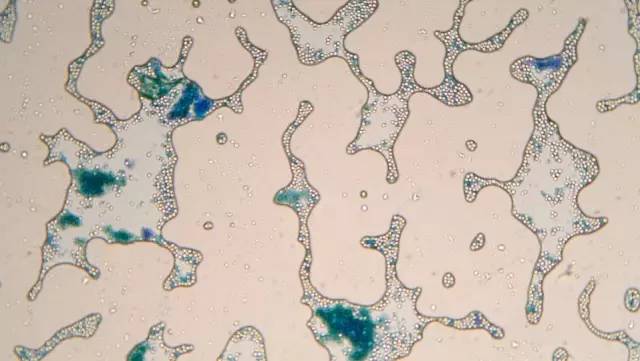
Yeast that works like a beast in beer
At this time, winemakers control the bad taste to be eaten more, and the good taste to be eaten less, which becomes subtraction from addition. This is the main reason why beer needs ripening and diacetyl reduction, and some bottled beers taste better after a long time, because the bad taste is getting less and less, and the quality of the wine becomes clearer and cleaner.
The fermentation of coffee
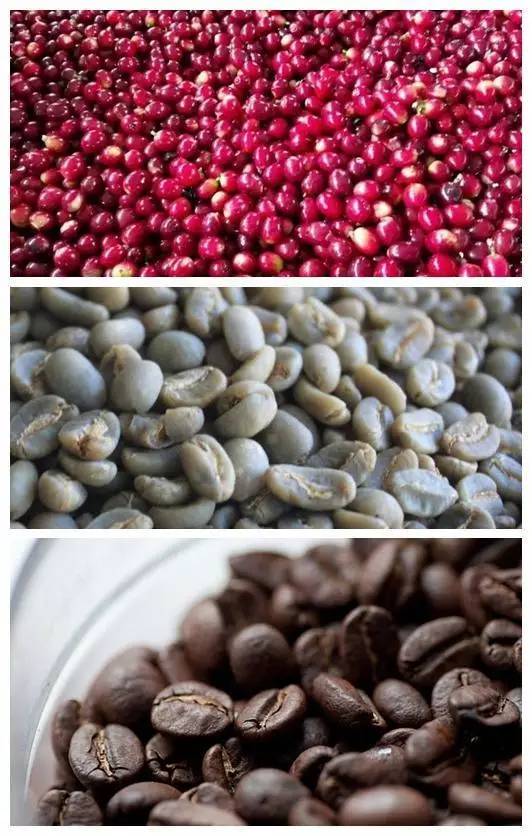
Coffee beans ferment, too?
Strictly speaking, coffee does not ferment this process, the basic process of coffee is coffee planting-> raw bean treatment-> cooked bean roasting-> coffee brewing. However, in this process of raw bean treatment, all kinds of treatment methods are inextricably related to fermentation.
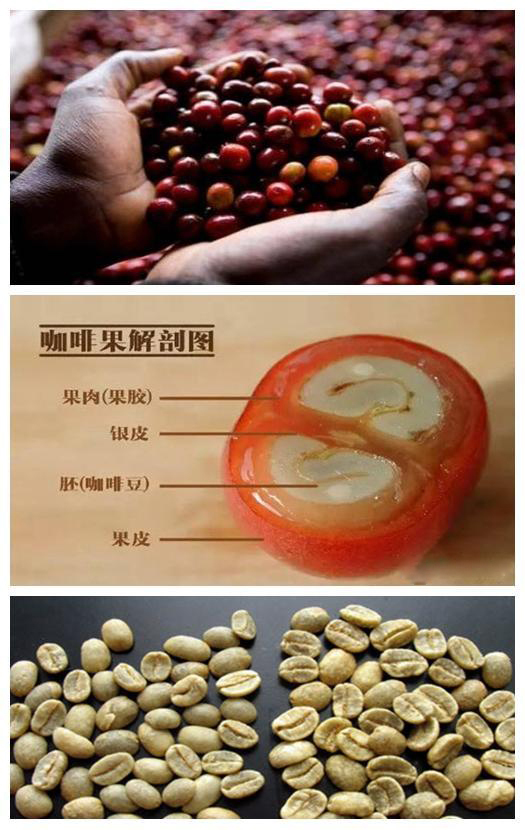
From fresh beans to raw beans
The treatment of raw coffee beans, in short, is the process of removing pectin from the pericarp. Among them, the pericarp is hard and brittle and can be broken off by mechanical means. Pectin is a sticky, sugar-rich gel that must be removed in some special way.
1. Sun treatment (Dry Processing):
This is the most traditional way to treat raw beans. After the coffee beans are harvested and dried by natural drying, the bright red coffee beans will become black Dry cherry as a result. After this process, the moisture content of coffee beans is reduced to 1112%.
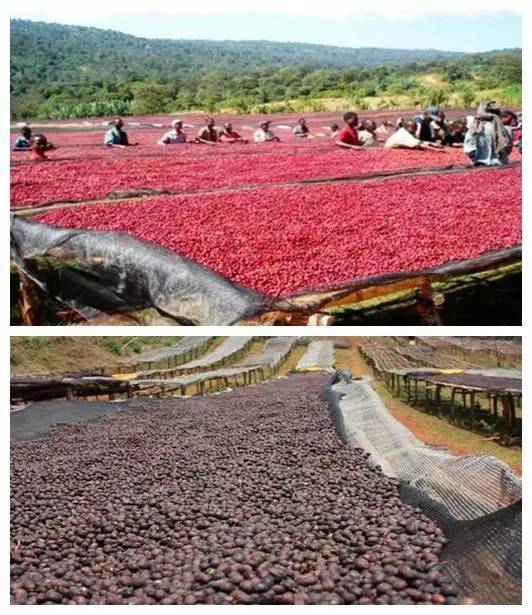
Sun treatment
The way of tanning is very simple, as long as the harvested coffee beans are spread out in the open air and dried in the sun for a few days. In order to unify the dryness of coffee beans, and to avoid excessive fermentation of coffee beans to produce peculiar smell, you need to turn from time to time in the process of exposure, and cover yourself with a layer of tarp to block the night dew after night.
After drying, the core and skin of the coffee will be separated, and then the pulp and peel will be removed by a sheller. Because the pericarp is rich in all kinds of yeast, the fermented flavor of sun-cured beans is the most obvious, but it is also prone to excessive fermentation. Yemenmoka, Isaiobiajara, Brazil and Sulawesi coffee beans are often treated with this method.
two。 Washing method (Wet Processing):
This technology, invented by the Dutch in the 18th century, is suitable for rainy areas. although the process is quite tedious, it is now a more common method of raw bean treatment, accounting for about 70% of the total coffee.
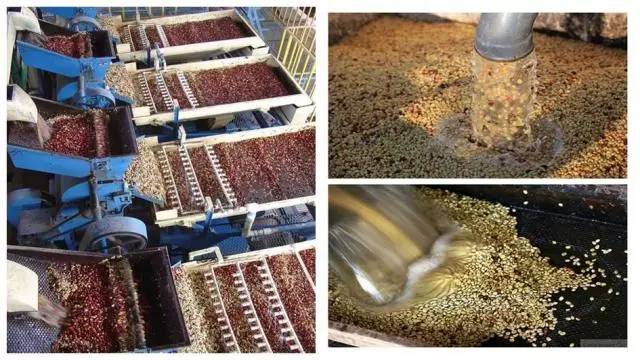
Washing method
Use a peeling machine to separate most of the peel and pulp from the coffee beans, guide them to a clean sink, soak them in water and ferment to completely remove the residual pectin. Through water treatment, unripe beans and defective beans are selected because of buoyancy, and the fermentation process is easier to control, so the flavor is not mixed like sun beans, but shows obvious sour and cleaner characteristics in the cup. But it is also because it is too "clean" and the richness of the flavor is a little weaker.
3. Wet planing (Wet-Hulling):
In the producing area of Mantenin: Sumatra, Indonesia, is a very humid area. In general, the raw coffee beans are dried and the moisture content is reduced to 12% or ripened for one to three months before the seed shells are removed. However, because Sumatra was too wet, wise local ancestors developed a unique wet planing method, that is, when the raw beans were half dried and the moisture content was as high as 30% to 50%, the peel was removed and then continued to dry in order to solve the problem of excessive drying time.
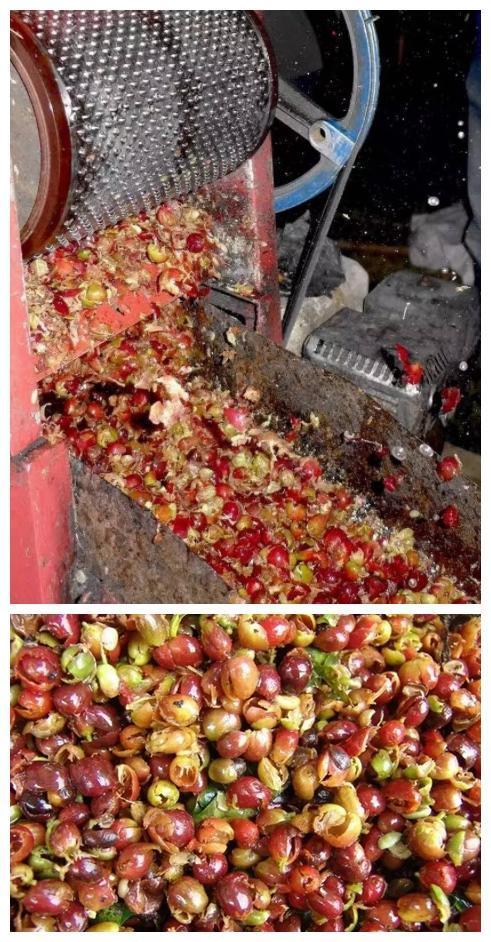
Drying before breaking the shell is called wet planing.
As the drying time is shortened to two to four days, the drying period of coffee beans is shortened, the acidity decreases, but the relative thickness increases, with obvious aromas of caramel and fruit, even with aromas of herbs or grass and wood. this is the unique flavor of Sumatra.
The effect of early peeling is that raw beans are half dried without peel to bask in the sun, which shortens the drying time, but the chance of raw beans being contaminated by molds, fungi and yeasts is also greatly increased. Interestingly, these factors have become the key factors in producing Manning's special aroma.
4. Honey treatment (Miel Process):
The meaning of honey treatment comes from the sticky pectin layer of coffee beans before exposure, which feels as sticky as honey. When the coffee pulp is separated from the coffee beans, the outer coated pectin layer is exposed to the sun, absorbing moisture in the air and making the pectin layer sticky.
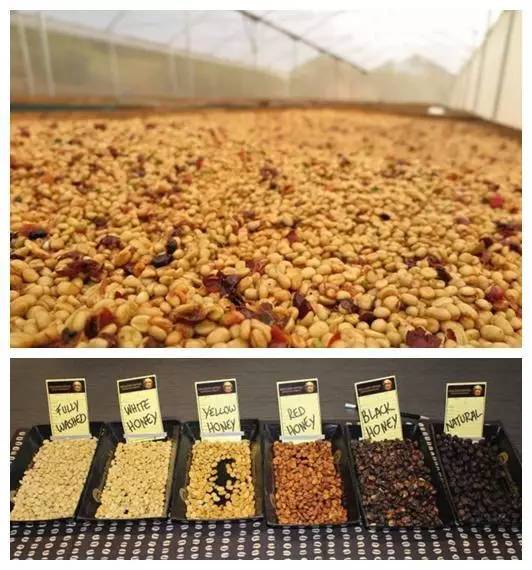
Breaking the shell before drying is called "honey treatment".
After the coffee beans are harvested, the fruit will first peel off the outer peel with a peel machine, leaving the flesh through the sun, so that the sweetness of the flesh can enter into the beans, without having to spend as long as the sun method. The honey treatment process is vulnerable to pollution and mildew, so it needs to be closely watched throughout the process, constantly turning, and speeding up drying, so as to avoid bad fermentation flavor.
The flavor of honey treatment is low acidity, high sweetness and fruity aroma. the cleanliness of the taste is higher than that of sun beans, and there is a tail of fermented wine after drying.
According to the different proportion of retained pectin and the drying method, it is divided into: 80% of the pectin of white honey (White Honey) is removed, 50% of the pectin of yellow honey (Yellow Honey) is retained, red honey (Red Honey) basically retains all pectin, and black honey (Black Honey) basically retains all pectin and is fermented at slightly high temperature. Central American countries such as Costa Rica and El Salvador are experts in honey processing.
5. Other processing methods:
In addition to the use of the above treatments, there are also the use of enzymes and digestive juices in the biological digestive tract to deal with raw coffee beans. Known creatures that can be used in this treatment are civets, fleshy crested birds, rhesus monkeys and elephants.
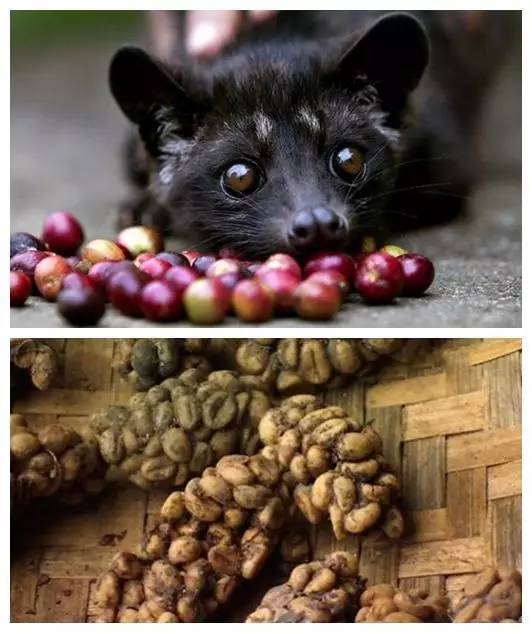
The criticized biological treatment method
The most famous is that the Indonesian coconut cat (that is, the civet) eats the sweetest and most juicy coffee fruit and ferments it in the stomach, destroying the protein and reducing the bitter taste of the coffee. As the coffee beans can not be digested, so after being discharged from the body, after artificial washing and roasting, it becomes what we call "Kopi Luwak" and "civet coffee".
The author is one of the few bakers who peel off a pile of poop and bake it. The taste of fresh Kopi Luwak is really not bad, with a special cheesy aroma and taste. But its high price and the fact of animal cruelty make people feel that such products should not be pursued too much.
Perhaps seeing such an expensive business opportunity for Kopi Luwak, professors at my alma mater extracted probiotics from Kopi Luwak beans in the laboratory, simulated digestion and fermentation in civets, tested different proportions of probiotics and changed the fermentation time.
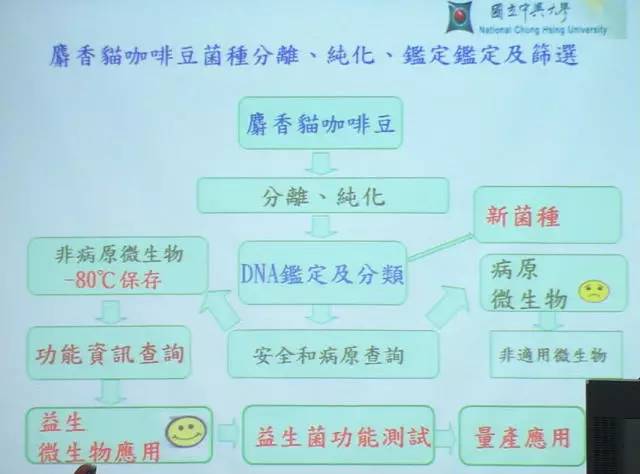
Here comes the Secret Book.
After probiotic fermentation, coffee beans change their proteins to produce sugars, short peptides and many free amino acids, reducing the bitterness and caffeine of coffee beans, and claim that trace pesticide residues and ochratoxin disappear due to probiotic natural fermentation. caffeine has been reduced to less than 1/3. The coffee got a high score of 94 on Coffee Review, indicating that fake Kopi Luwak is not bad.
This article briefly explains the effects of fermentation on beer and coffee. I hope readers can raise a little bit.
Important Notice :
前街咖啡 FrontStreet Coffee has moved to new addredd:
FrontStreet Coffee Address: 315,Donghua East Road,GuangZhou
Tel:020 38364473
- Prev
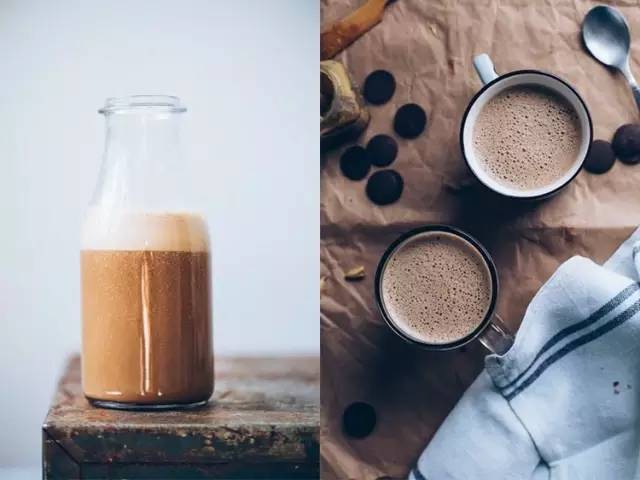
Recommend some unpopular coffee mash-ups.
Follow the caf é (Wechat official account vdailycom) found that there are more ways to open a beautiful cafe to open its own shop, whether you are coffee-controlled or not, Rank is high or low, the following unpopular coffee mash-ups let you open the door to a new world of coffee ~ Bulletproof Coffee glossy buttered coffee that can lose weight after watching Harry Potter, it's hard to forget.
- Next

2017 detailed illustration of the fusion skills of coffee and milk
Following Kaiping (Wechat official account vdailycom) found that Beautiful Cafe opened a small shop of its own. As we all know, Lahua is based on Italian concentration to make a beautiful milk bubble design. To be able to do a beautiful flower pull is probably what every barista wants to do. In fact, the essence of each cup of flower is the hydrological collision between milk and espresso.
Related
- What is the meaning of lactic acid fermentation with coffee bean treatment?
- How to judge the state of foam by sound?
- How does the latte pull out the unicorn pattern? Come to get for a little trick to improve the flower pull!
- Will flower pulling affect the taste of the latte?
- Do you know the history of coffee?
- The difference between honey treatment and sun washing what is raisin honey treatment?
- What kind of milk can a novice use to make coffee foam to keep the foam longer? The correct method and skills of milking tutorial sharing
- Why do washed coffee beans taste sour? Flavor characteristics of washed Coffee
- Introduction to the skill of how to practice the size and height of water injection around the circle of hand-brewed coffee
- How do beginners practice coffee flower drawing from scratch?

